Cyber Law Case Study: Zappos.com & Verizon v. FCC Analysis
VerifiedAdded on 2022/10/10
|7
|1553
|368
Case Study
AI Summary
This assignment presents a comprehensive analysis of two significant cyber law case studies: the Zappos.com customer data security breach litigation and Verizon v. FCC. The Zappos case explores the vulnerability of customer data and the legal implications of the company's terms of use, arbitration law, and the IT Act of 2000. The Verizon case delves into issues surrounding internet marketplace, FCC's regulations on broadband service rates, and the Telecommunications Act of 1996. The analysis covers the facts of each case, the issues at hand, the arguments presented by the involved parties, and the applicable cyber laws. The Zappos analysis considers the role of the hacker and the terms of use, while the Verizon analysis focuses on the implications of the Telecommunications Act of 1996 and the need for regulatory adjustments. Both cases offer insights into the challenges and complexities of cyber law in the digital age. The paper follows APA format and includes scholarly references.
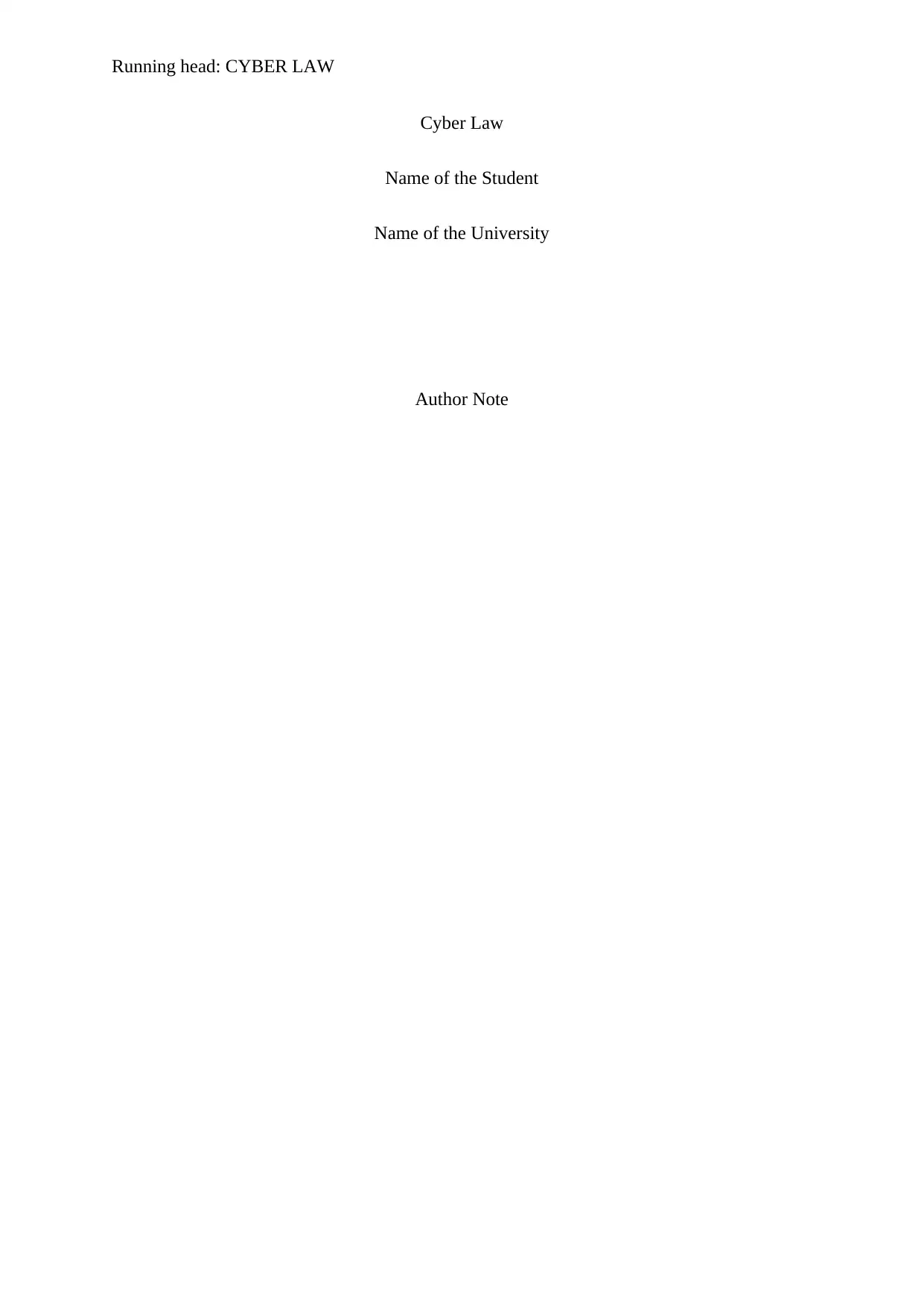
Running head: CYBER LAW
Cyber Law
Name of the Student
Name of the University
Author Note
Cyber Law
Name of the Student
Name of the University
Author Note
Paraphrase This Document
Need a fresh take? Get an instant paraphrase of this document with our AI Paraphraser
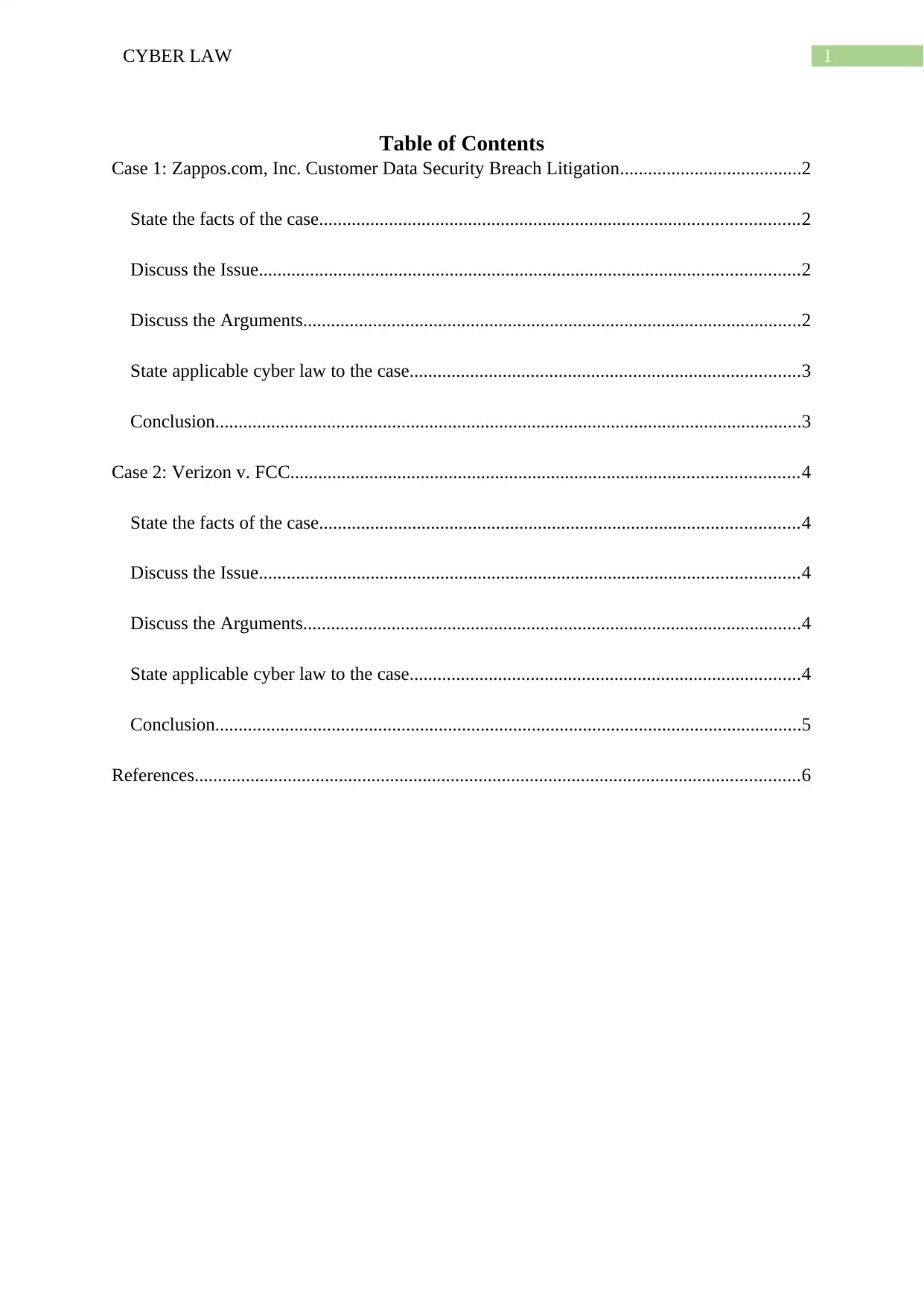
1CYBER LAW
Table of Contents
Case 1: Zappos.com, Inc. Customer Data Security Breach Litigation.......................................2
State the facts of the case.......................................................................................................2
Discuss the Issue....................................................................................................................2
Discuss the Arguments...........................................................................................................2
State applicable cyber law to the case....................................................................................3
Conclusion..............................................................................................................................3
Case 2: Verizon v. FCC.............................................................................................................4
State the facts of the case.......................................................................................................4
Discuss the Issue....................................................................................................................4
Discuss the Arguments...........................................................................................................4
State applicable cyber law to the case....................................................................................4
Conclusion..............................................................................................................................5
References..................................................................................................................................6
Table of Contents
Case 1: Zappos.com, Inc. Customer Data Security Breach Litigation.......................................2
State the facts of the case.......................................................................................................2
Discuss the Issue....................................................................................................................2
Discuss the Arguments...........................................................................................................2
State applicable cyber law to the case....................................................................................3
Conclusion..............................................................................................................................3
Case 2: Verizon v. FCC.............................................................................................................4
State the facts of the case.......................................................................................................4
Discuss the Issue....................................................................................................................4
Discuss the Arguments...........................................................................................................4
State applicable cyber law to the case....................................................................................4
Conclusion..............................................................................................................................5
References..................................................................................................................................6
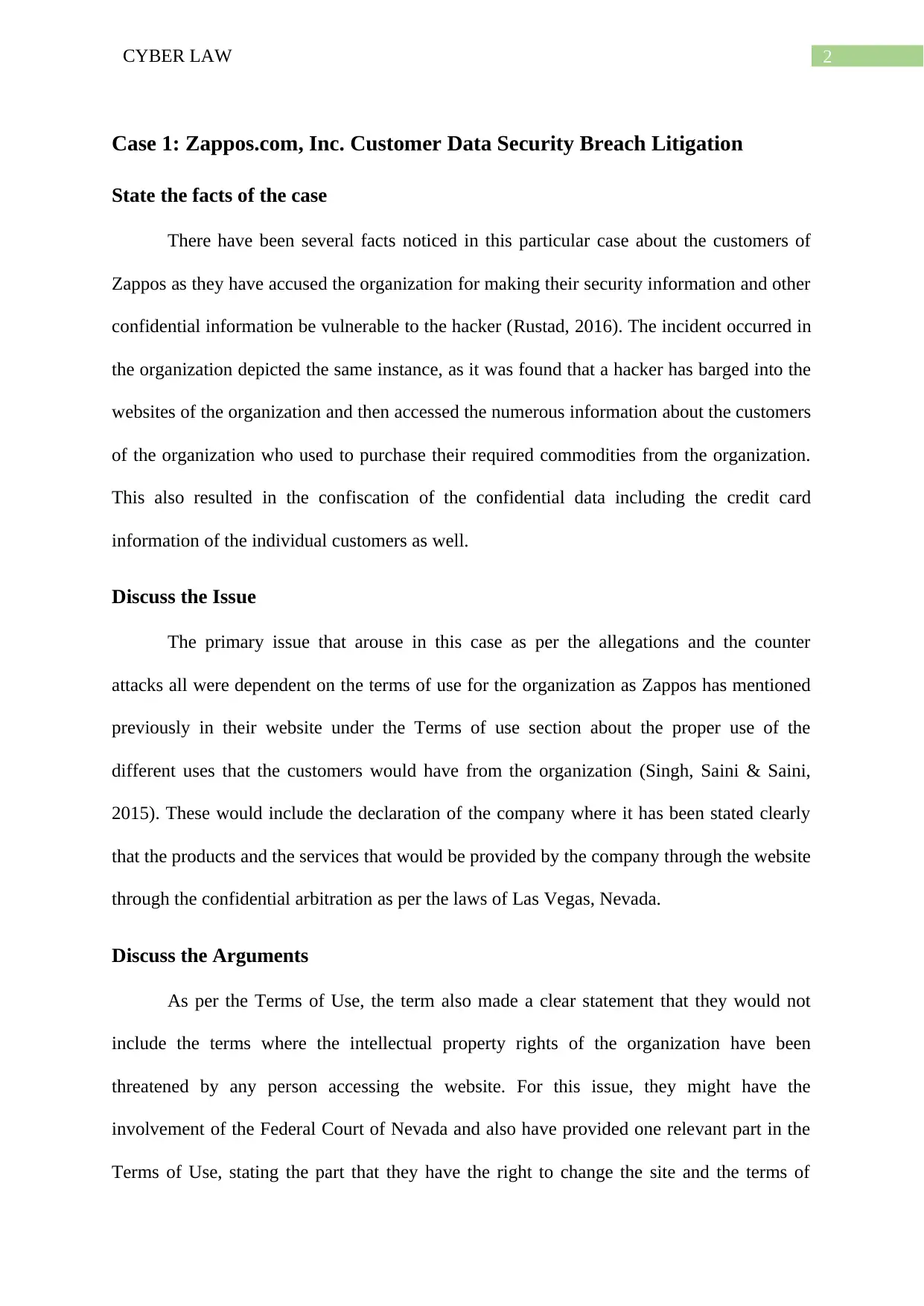
2CYBER LAW
Case 1: Zappos.com, Inc. Customer Data Security Breach Litigation
State the facts of the case
There have been several facts noticed in this particular case about the customers of
Zappos as they have accused the organization for making their security information and other
confidential information be vulnerable to the hacker (Rustad, 2016). The incident occurred in
the organization depicted the same instance, as it was found that a hacker has barged into the
websites of the organization and then accessed the numerous information about the customers
of the organization who used to purchase their required commodities from the organization.
This also resulted in the confiscation of the confidential data including the credit card
information of the individual customers as well.
Discuss the Issue
The primary issue that arouse in this case as per the allegations and the counter
attacks all were dependent on the terms of use for the organization as Zappos has mentioned
previously in their website under the Terms of use section about the proper use of the
different uses that the customers would have from the organization (Singh, Saini & Saini,
2015). These would include the declaration of the company where it has been stated clearly
that the products and the services that would be provided by the company through the website
through the confidential arbitration as per the laws of Las Vegas, Nevada.
Discuss the Arguments
As per the Terms of Use, the term also made a clear statement that they would not
include the terms where the intellectual property rights of the organization have been
threatened by any person accessing the website. For this issue, they might have the
involvement of the Federal Court of Nevada and also have provided one relevant part in the
Terms of Use, stating the part that they have the right to change the site and the terms of
Case 1: Zappos.com, Inc. Customer Data Security Breach Litigation
State the facts of the case
There have been several facts noticed in this particular case about the customers of
Zappos as they have accused the organization for making their security information and other
confidential information be vulnerable to the hacker (Rustad, 2016). The incident occurred in
the organization depicted the same instance, as it was found that a hacker has barged into the
websites of the organization and then accessed the numerous information about the customers
of the organization who used to purchase their required commodities from the organization.
This also resulted in the confiscation of the confidential data including the credit card
information of the individual customers as well.
Discuss the Issue
The primary issue that arouse in this case as per the allegations and the counter
attacks all were dependent on the terms of use for the organization as Zappos has mentioned
previously in their website under the Terms of use section about the proper use of the
different uses that the customers would have from the organization (Singh, Saini & Saini,
2015). These would include the declaration of the company where it has been stated clearly
that the products and the services that would be provided by the company through the website
through the confidential arbitration as per the laws of Las Vegas, Nevada.
Discuss the Arguments
As per the Terms of Use, the term also made a clear statement that they would not
include the terms where the intellectual property rights of the organization have been
threatened by any person accessing the website. For this issue, they might have the
involvement of the Federal Court of Nevada and also have provided one relevant part in the
Terms of Use, stating the part that they have the right to change the site and the terms of
⊘ This is a preview!⊘
Do you want full access?
Subscribe today to unlock all pages.

Trusted by 1+ million students worldwide
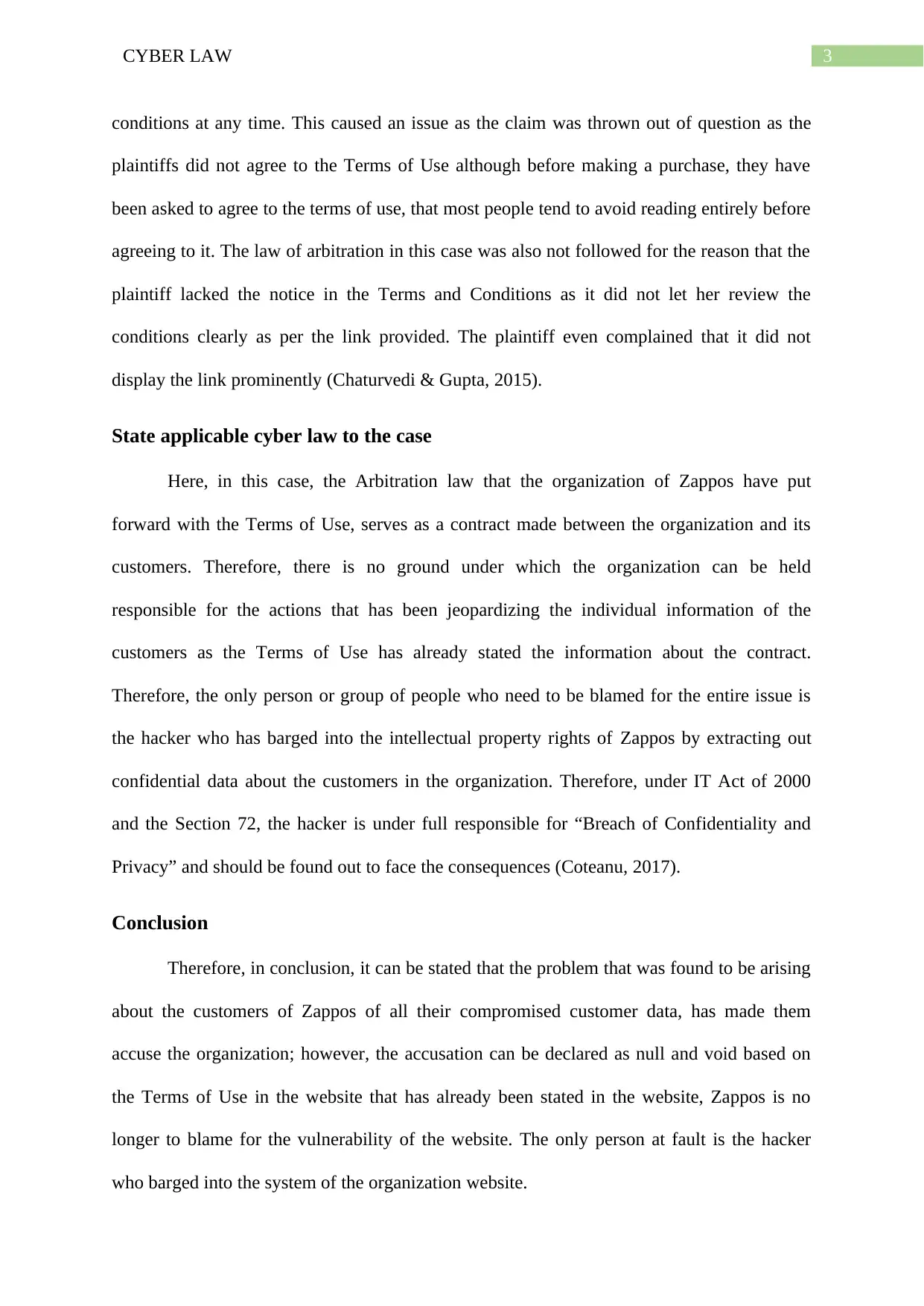
3CYBER LAW
conditions at any time. This caused an issue as the claim was thrown out of question as the
plaintiffs did not agree to the Terms of Use although before making a purchase, they have
been asked to agree to the terms of use, that most people tend to avoid reading entirely before
agreeing to it. The law of arbitration in this case was also not followed for the reason that the
plaintiff lacked the notice in the Terms and Conditions as it did not let her review the
conditions clearly as per the link provided. The plaintiff even complained that it did not
display the link prominently (Chaturvedi & Gupta, 2015).
State applicable cyber law to the case
Here, in this case, the Arbitration law that the organization of Zappos have put
forward with the Terms of Use, serves as a contract made between the organization and its
customers. Therefore, there is no ground under which the organization can be held
responsible for the actions that has been jeopardizing the individual information of the
customers as the Terms of Use has already stated the information about the contract.
Therefore, the only person or group of people who need to be blamed for the entire issue is
the hacker who has barged into the intellectual property rights of Zappos by extracting out
confidential data about the customers in the organization. Therefore, under IT Act of 2000
and the Section 72, the hacker is under full responsible for “Breach of Confidentiality and
Privacy” and should be found out to face the consequences (Coteanu, 2017).
Conclusion
Therefore, in conclusion, it can be stated that the problem that was found to be arising
about the customers of Zappos of all their compromised customer data, has made them
accuse the organization; however, the accusation can be declared as null and void based on
the Terms of Use in the website that has already been stated in the website, Zappos is no
longer to blame for the vulnerability of the website. The only person at fault is the hacker
who barged into the system of the organization website.
conditions at any time. This caused an issue as the claim was thrown out of question as the
plaintiffs did not agree to the Terms of Use although before making a purchase, they have
been asked to agree to the terms of use, that most people tend to avoid reading entirely before
agreeing to it. The law of arbitration in this case was also not followed for the reason that the
plaintiff lacked the notice in the Terms and Conditions as it did not let her review the
conditions clearly as per the link provided. The plaintiff even complained that it did not
display the link prominently (Chaturvedi & Gupta, 2015).
State applicable cyber law to the case
Here, in this case, the Arbitration law that the organization of Zappos have put
forward with the Terms of Use, serves as a contract made between the organization and its
customers. Therefore, there is no ground under which the organization can be held
responsible for the actions that has been jeopardizing the individual information of the
customers as the Terms of Use has already stated the information about the contract.
Therefore, the only person or group of people who need to be blamed for the entire issue is
the hacker who has barged into the intellectual property rights of Zappos by extracting out
confidential data about the customers in the organization. Therefore, under IT Act of 2000
and the Section 72, the hacker is under full responsible for “Breach of Confidentiality and
Privacy” and should be found out to face the consequences (Coteanu, 2017).
Conclusion
Therefore, in conclusion, it can be stated that the problem that was found to be arising
about the customers of Zappos of all their compromised customer data, has made them
accuse the organization; however, the accusation can be declared as null and void based on
the Terms of Use in the website that has already been stated in the website, Zappos is no
longer to blame for the vulnerability of the website. The only person at fault is the hacker
who barged into the system of the organization website.
Paraphrase This Document
Need a fresh take? Get an instant paraphrase of this document with our AI Paraphraser
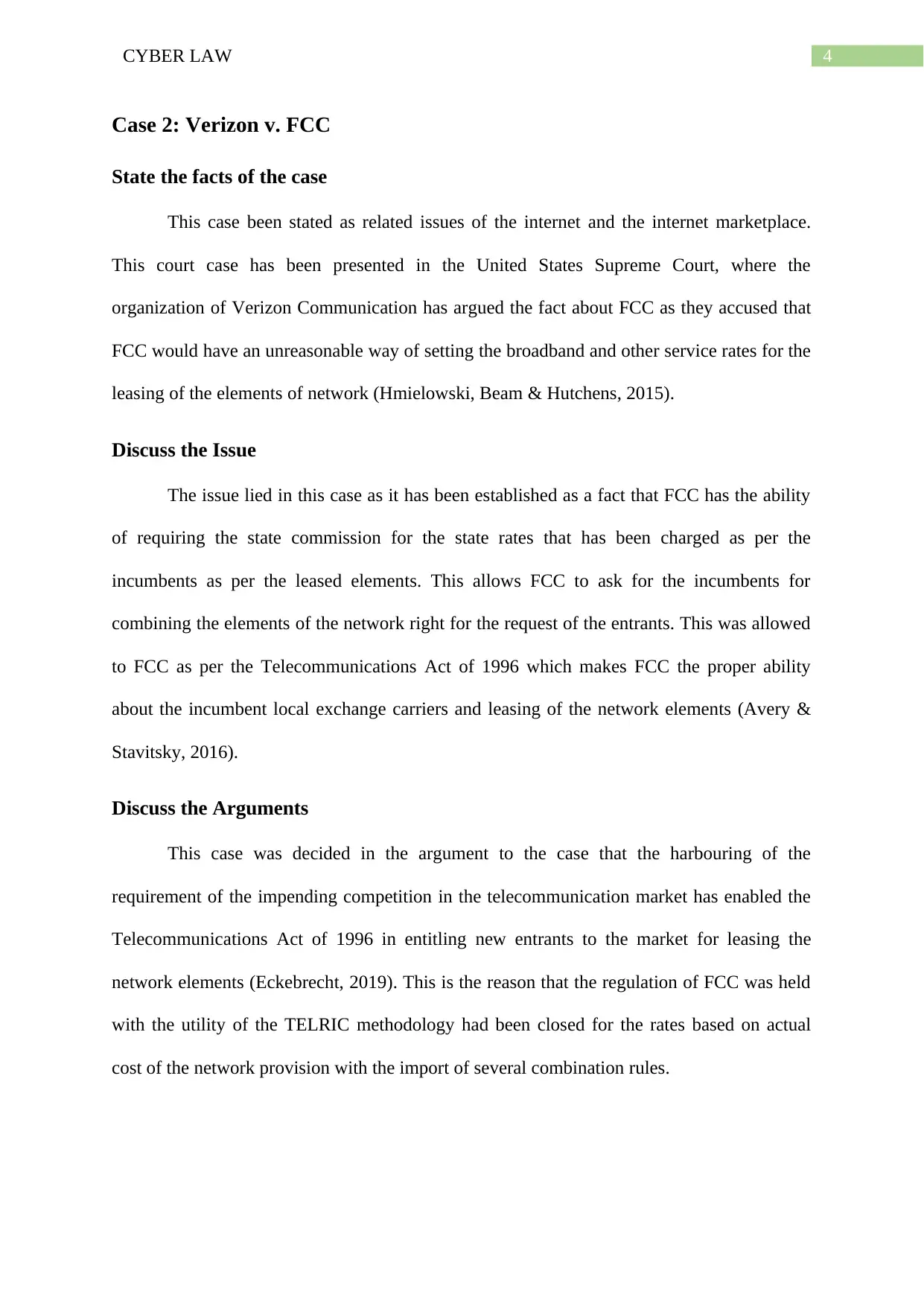
4CYBER LAW
Case 2: Verizon v. FCC
State the facts of the case
This case been stated as related issues of the internet and the internet marketplace.
This court case has been presented in the United States Supreme Court, where the
organization of Verizon Communication has argued the fact about FCC as they accused that
FCC would have an unreasonable way of setting the broadband and other service rates for the
leasing of the elements of network (Hmielowski, Beam & Hutchens, 2015).
Discuss the Issue
The issue lied in this case as it has been established as a fact that FCC has the ability
of requiring the state commission for the state rates that has been charged as per the
incumbents as per the leased elements. This allows FCC to ask for the incumbents for
combining the elements of the network right for the request of the entrants. This was allowed
to FCC as per the Telecommunications Act of 1996 which makes FCC the proper ability
about the incumbent local exchange carriers and leasing of the network elements (Avery &
Stavitsky, 2016).
Discuss the Arguments
This case was decided in the argument to the case that the harbouring of the
requirement of the impending competition in the telecommunication market has enabled the
Telecommunications Act of 1996 in entitling new entrants to the market for leasing the
network elements (Eckebrecht, 2019). This is the reason that the regulation of FCC was held
with the utility of the TELRIC methodology had been closed for the rates based on actual
cost of the network provision with the import of several combination rules.
Case 2: Verizon v. FCC
State the facts of the case
This case been stated as related issues of the internet and the internet marketplace.
This court case has been presented in the United States Supreme Court, where the
organization of Verizon Communication has argued the fact about FCC as they accused that
FCC would have an unreasonable way of setting the broadband and other service rates for the
leasing of the elements of network (Hmielowski, Beam & Hutchens, 2015).
Discuss the Issue
The issue lied in this case as it has been established as a fact that FCC has the ability
of requiring the state commission for the state rates that has been charged as per the
incumbents as per the leased elements. This allows FCC to ask for the incumbents for
combining the elements of the network right for the request of the entrants. This was allowed
to FCC as per the Telecommunications Act of 1996 which makes FCC the proper ability
about the incumbent local exchange carriers and leasing of the network elements (Avery &
Stavitsky, 2016).
Discuss the Arguments
This case was decided in the argument to the case that the harbouring of the
requirement of the impending competition in the telecommunication market has enabled the
Telecommunications Act of 1996 in entitling new entrants to the market for leasing the
network elements (Eckebrecht, 2019). This is the reason that the regulation of FCC was held
with the utility of the TELRIC methodology had been closed for the rates based on actual
cost of the network provision with the import of several combination rules.
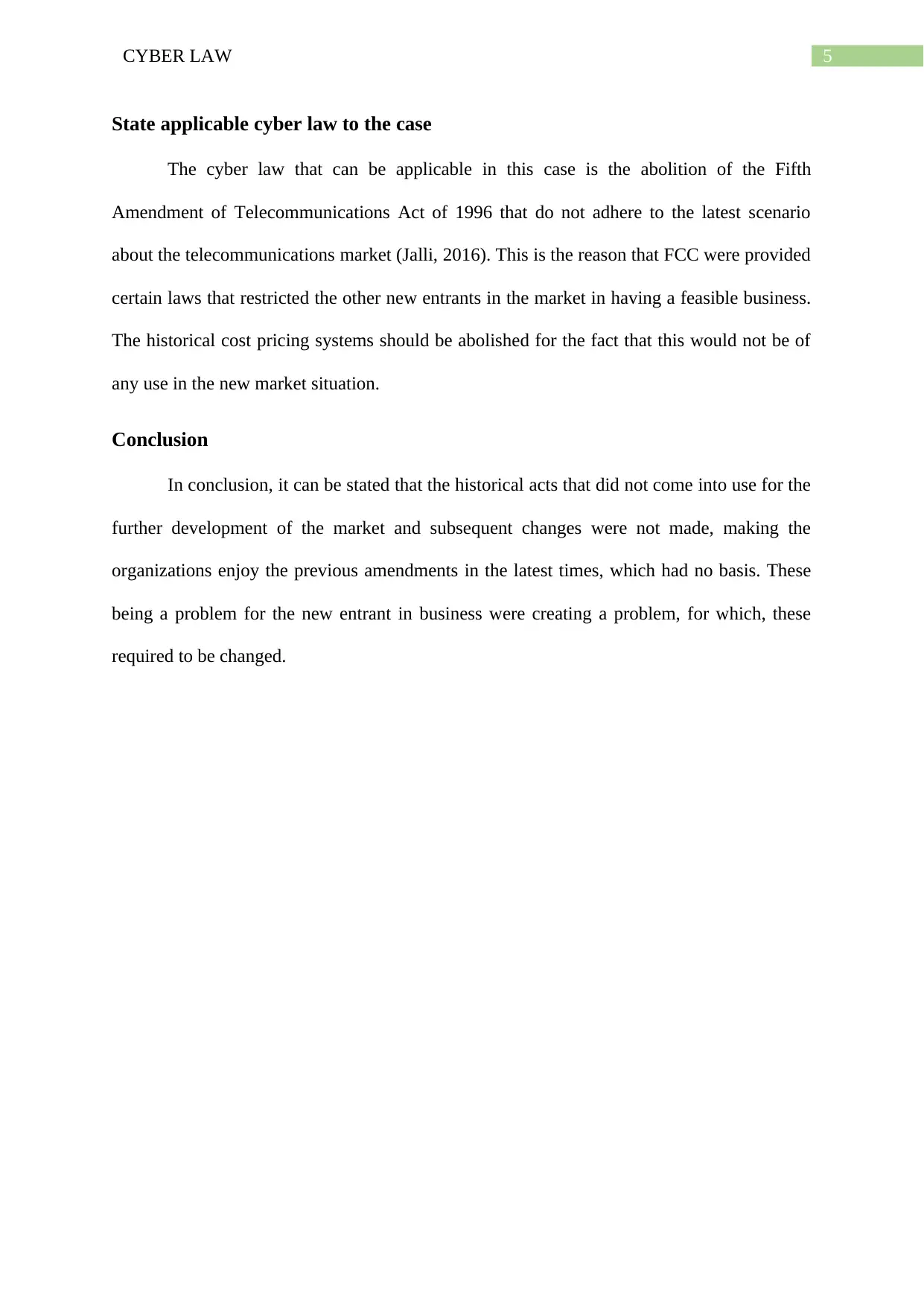
5CYBER LAW
State applicable cyber law to the case
The cyber law that can be applicable in this case is the abolition of the Fifth
Amendment of Telecommunications Act of 1996 that do not adhere to the latest scenario
about the telecommunications market (Jalli, 2016). This is the reason that FCC were provided
certain laws that restricted the other new entrants in the market in having a feasible business.
The historical cost pricing systems should be abolished for the fact that this would not be of
any use in the new market situation.
Conclusion
In conclusion, it can be stated that the historical acts that did not come into use for the
further development of the market and subsequent changes were not made, making the
organizations enjoy the previous amendments in the latest times, which had no basis. These
being a problem for the new entrant in business were creating a problem, for which, these
required to be changed.
State applicable cyber law to the case
The cyber law that can be applicable in this case is the abolition of the Fifth
Amendment of Telecommunications Act of 1996 that do not adhere to the latest scenario
about the telecommunications market (Jalli, 2016). This is the reason that FCC were provided
certain laws that restricted the other new entrants in the market in having a feasible business.
The historical cost pricing systems should be abolished for the fact that this would not be of
any use in the new market situation.
Conclusion
In conclusion, it can be stated that the historical acts that did not come into use for the
further development of the market and subsequent changes were not made, making the
organizations enjoy the previous amendments in the latest times, which had no basis. These
being a problem for the new entrant in business were creating a problem, for which, these
required to be changed.
⊘ This is a preview!⊘
Do you want full access?
Subscribe today to unlock all pages.

Trusted by 1+ million students worldwide
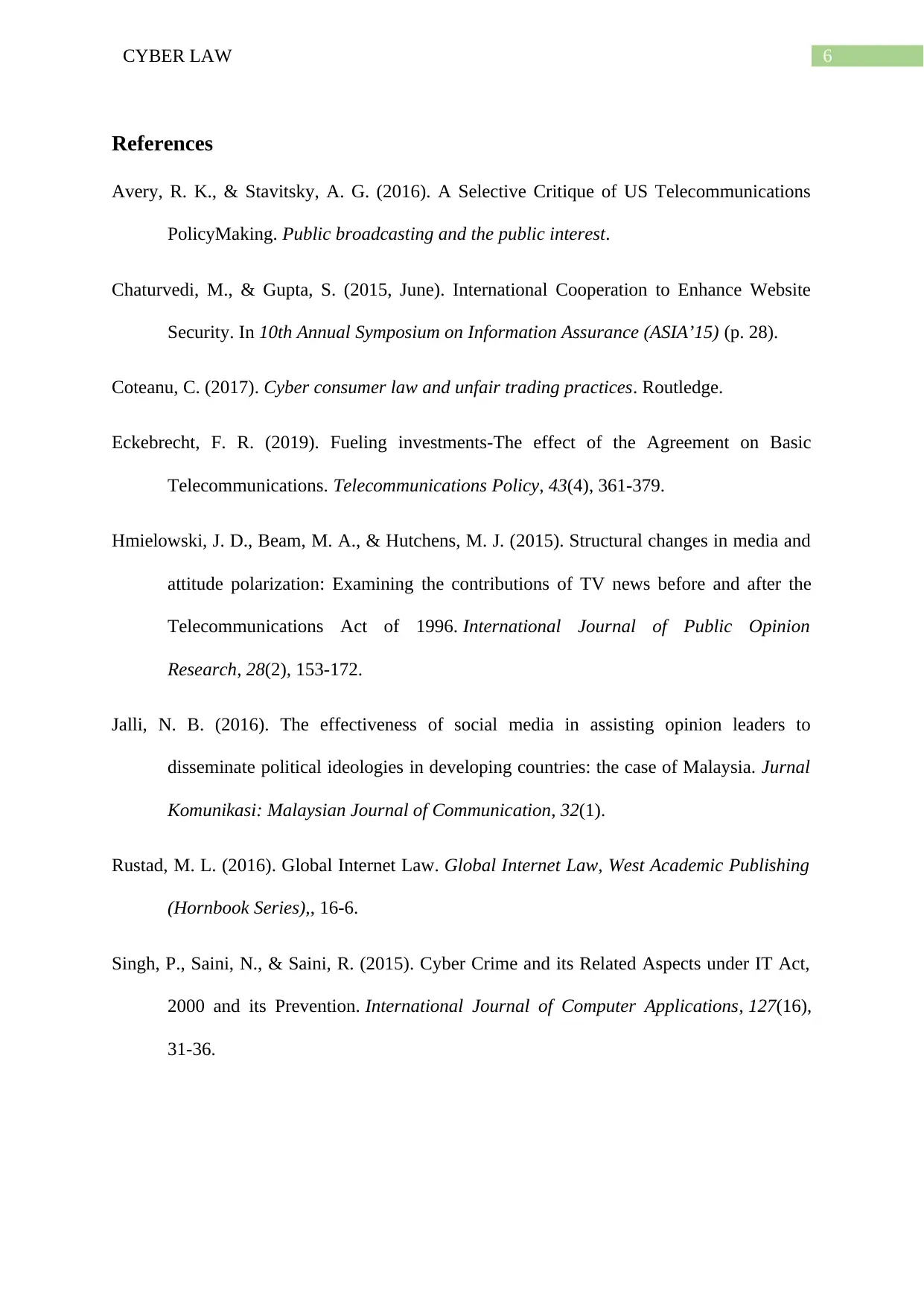
6CYBER LAW
References
Avery, R. K., & Stavitsky, A. G. (2016). A Selective Critique of US Telecommunications
PolicyMaking. Public broadcasting and the public interest.
Chaturvedi, M., & Gupta, S. (2015, June). International Cooperation to Enhance Website
Security. In 10th Annual Symposium on Information Assurance (ASIA’15) (p. 28).
Coteanu, C. (2017). Cyber consumer law and unfair trading practices. Routledge.
Eckebrecht, F. R. (2019). Fueling investments-The effect of the Agreement on Basic
Telecommunications. Telecommunications Policy, 43(4), 361-379.
Hmielowski, J. D., Beam, M. A., & Hutchens, M. J. (2015). Structural changes in media and
attitude polarization: Examining the contributions of TV news before and after the
Telecommunications Act of 1996. International Journal of Public Opinion
Research, 28(2), 153-172.
Jalli, N. B. (2016). The effectiveness of social media in assisting opinion leaders to
disseminate political ideologies in developing countries: the case of Malaysia. Jurnal
Komunikasi: Malaysian Journal of Communication, 32(1).
Rustad, M. L. (2016). Global Internet Law. Global Internet Law, West Academic Publishing
(Hornbook Series),, 16-6.
Singh, P., Saini, N., & Saini, R. (2015). Cyber Crime and its Related Aspects under IT Act,
2000 and its Prevention. International Journal of Computer Applications, 127(16),
31-36.
References
Avery, R. K., & Stavitsky, A. G. (2016). A Selective Critique of US Telecommunications
PolicyMaking. Public broadcasting and the public interest.
Chaturvedi, M., & Gupta, S. (2015, June). International Cooperation to Enhance Website
Security. In 10th Annual Symposium on Information Assurance (ASIA’15) (p. 28).
Coteanu, C. (2017). Cyber consumer law and unfair trading practices. Routledge.
Eckebrecht, F. R. (2019). Fueling investments-The effect of the Agreement on Basic
Telecommunications. Telecommunications Policy, 43(4), 361-379.
Hmielowski, J. D., Beam, M. A., & Hutchens, M. J. (2015). Structural changes in media and
attitude polarization: Examining the contributions of TV news before and after the
Telecommunications Act of 1996. International Journal of Public Opinion
Research, 28(2), 153-172.
Jalli, N. B. (2016). The effectiveness of social media in assisting opinion leaders to
disseminate political ideologies in developing countries: the case of Malaysia. Jurnal
Komunikasi: Malaysian Journal of Communication, 32(1).
Rustad, M. L. (2016). Global Internet Law. Global Internet Law, West Academic Publishing
(Hornbook Series),, 16-6.
Singh, P., Saini, N., & Saini, R. (2015). Cyber Crime and its Related Aspects under IT Act,
2000 and its Prevention. International Journal of Computer Applications, 127(16),
31-36.
1 out of 7
Related Documents
Your All-in-One AI-Powered Toolkit for Academic Success.
+13062052269
info@desklib.com
Available 24*7 on WhatsApp / Email
![[object Object]](/_next/static/media/star-bottom.7253800d.svg)
Unlock your academic potential
Copyright © 2020–2025 A2Z Services. All Rights Reserved. Developed and managed by ZUCOL.





